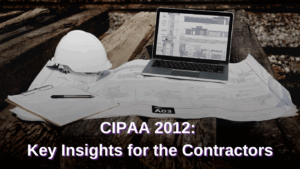Tay & Partners | View firm profile
Introduction
In the construction industry, cash flow is king. The Construction Industry Payment and Adjudication Act 2012 (“CIPAA”) came into force on 15 April 2014 with its main objective to resolve payment dispute and improve the contractors’ cash flow by providing a speedy, timely and cost-effective dispute resolution mechanism through adjudication.
Under CIPAA, an adjudication proceeding generally takes around 100 working days from the date of serving the payment claim until the release of the adjudication decision. The adjudication decision is binding until it is set aside by the High Court or the dispute is finally decided in court litigation or arbitration. This means that the contractors do not have to endure lengthy court battles just to get paid — they have a clear path to speedier resolution of dispute through adjudication.
In this article, we will address some common concerns faced by the contractors and subcontractors, to provide a better understanding of CIPAA 2012.
I. Conditional Payment: Void Under Section 35 of CIPAA 2012
Conditional payment clause, also known as “pay-when-paid”, “pay-if-paid” or “back-to-back” clause, makes the obligation to pay one party (e.g., sub-contractor) contingents upon another party (e.g., main contractor) receiving payment from a third party (e.g. employer).
The conditional payment clause is commonly found in construction contracts, especially between the main contractors and subcontractors.
However, it is void under Section 35 of CIPAA 2012. This is because the main objective of CIPAA 2012 is to provide a speedy resolution of payment dispute and to alleviate the cash flow issues. Section 35(1) of CIPAA 2012 provides as follows:
“35 Prohibition of conditional payment
(1) Any conditional payment provision in a construction contract in relation to payment under the construction contract is void.
(2) For the purposes of this section, it is a conditional payment provision when –
(a) the obligation of one party to make payment is conditional upon that party having received payment from a third party; or
(b) the obligation of one party to make payment is conditional upon the availability of funds or drawdown of financing facilities of that party.”
In the case of Econpile (M) Sdn Bhd v IRDK Ventures Sdn Bhd and another case [2017] 7 MLJ 732, the respondent contends that under clause 25.4(d) of PAM Contract 2006, he is not bound to make further payment including payments which have been certified but not yet paid after the claimant’s contract has been terminated. The High Court held that clause 25.4(d) has the effect, upon the termination of the contract, of postponing payment due until the final accounts are concluded and the works completed. This would defeat the purpose of CIPAA 2012 and is therefore void and unenforceable.
Recently, the Court of Appeal in SPM Energy Sdn Bhd & Anor v Multi Discovery Sdn Bhd [2025] MLJU 515 held that the prohibition of conditional payment clause under Section 35 of CIPAA 2012 applies to disputes before court / arbitral proceedings when there are no adjudication proceedings. As such, it appears that the prohibition of conditional payment extends beyond the adjudication proceedings. The Court of Appeal held that the prohibition under Section 35 of CIPAA 2012 would apply in court or arbitral tribunal if 4 cumulative conditions under Section 2 of CIPAA 2012 are satisfied, subject to 2 exceptions i.e., the existence of circumstances stipulated in Section 3 of CIPAA and the exemption by the Minister under Section 40 of CIPAA 2012.
The 4 cumulative conditions for the prohibition under Section 35 of CIPAA 2012 to apply are as follows:
(a) there is a “construction contract” as understood in Section 4 of CIPAA;
(b) the construction contract is made in writing;
(c) the construction contract relates to “construction work” as defined in Section 4 of CIPAA; and
(d) the construction work is carried out wholly or partly within the territory in Malaysia.
However, not all “delayed payment” provisions are deemed “conditional payment” under Section 35 of CIPAA 2012. The Court of Appeal in the case of Lion Pacific Sdn Bhd v Pestech Technology Sdn Bhd and another appeal [2022] 6 MLJ 967 held that a “pay-if-certified” clause cannot be construed as a conditional payment clause under Section 35 of CIPAA 2012, as the mutual agreement of the parties was that the appellant’s obligation to make payment would only arise upon certification of the works done by the Ministry of Transport, failing which the works cannot be considered as having been carried out. The Court of Appeal also stressed that whilst CIPAA 2012 was intended to alleviate cash flow problems and prohibited conditional payments, it was not intended to replace the requirement of certification or valuation to assess the progress of works carried out.
II. Crossclaims can only Zerorise the Claimant’s Claim, Not Exceed
When an unpaid party (the claimant) commence an adjudication proceeding to claim for the unpaid work done, it is common that the non-paying party (the respondent) would raise a crossclaim, set off or back charges (e.g., rectification/defective works or liquidated ascertained damages (LAD)) against the claimant.
However, it is important to note that under CIPAA, a crossclaim can only reduce or “zerorise” the claimant’s claim but it cannot exceed the amount claimed by the claimant. If the adjudicator allows a crossclaim exceeding the claimant’s claim and orders the claimant to pay the respondent, the adjudicator would have exceeded his or her jurisdiction and the adjudication decision may be set aside under Section 15(d) of CIPAA 2012 (see: the Court of Appeal’s decision in Tera Va Sdn Bhd v Ayam Bintang Istimewa Sdn Bhd [2024] 6 MLJ 849).
III. Section 30 CIPAA 2012: An Effective Tool for Subcontractors
On the other hand, when a subcontractor wins an adjudication proceeding and obtains an adjudication decision in its favour, the battle is not over – the respondent (main contractor) may refuse to comply with the adjudication decision to pay the subcontractor.
Apart from enforcing the adjudication decision in the High Court under Section 28 of CIPAA 2012, Section 30 of CIPAA 2012 allows the subcontractor to request payment of the adjudicated sum directly from the principal (e.g. employer), bypassing the main contractor.
Section 30 of CIPAA 2012 reads as follows:
“30 Direct Payment from principal
(1) If a party against whom an adjudication decision was made fails to make payment of the adjudicated amount, the party who obtained the adjudication decision in his favour may make a written request for payment of the adjudicated amount direct from the principal of the party against whom the adjudication decision is made.
(2) Upon receipt of the written request under subsection (1), the principal shall serve a notice in writing on the party against whom the adjudication decision was made to show proof of payment and to state that direct payment would be made after the expiry of ten working days of the service of the notice.
(3) In the absence of proof of payment requested under subsection (2), the principal shall pay the adjudicated amount to the party who obtained the adjudication decision in his favour.
(4) The principal may recover the amount paid under subsection (3) as a debt or set off the same from any money due or payable by the principal to the party against whom the adjudication decision was made.
(5) This section shall only be invoked if money is due or payable by the principal to the party against whom the adjudication decision was made at the time of the receipt of the request under subsection (1).”
Based on Section 30 of CIPAA 2012 above, the conditions to be met for the direct payment mechanism to work are as follows:
(a) 1st condition: The main contractor failed to pay the adjudicated amount to the subcontractor (section 30(1) and (3) of CIPAA);
(b) 2nd condition: The subcontractor made a written request for the principal to pay the adjudicated amount directly to the subcontractor (section 30(1) of CIPAA);
(c) 3rd condition: There is a sum of money due from the principal to the main contractor at the time of the principal’s receipt of the subcontractor’s written request (section 30(5) of CIPAA); and
(d) 4th condition: The principal did not comply with the subcontractor’s written request and did not pay the adjudicated amount directly to the subcontractor. However, if the principal pays the adjudicated amount directly to the subcontractor, it could recover the adjudicated amount from its main contractor as debt or set off (section 30(4) of CIPAA).
Among the conditions, Section 30(5) of CIPAA 2012 (the 3rd condition) is the most fundamental pre-condition to be satisfied before the subcontractor could “activate” the direct payment mechanism from the principal (see: the Court of Appeal’s decision in JDI Builtech (M) Sdn Bhd v Danga Jed Development Malaysia Sdn Bhd (previously known as Greenland Danga Bay Sdn Bhd) [2024] 4 MLJ 29).
Despite this, Section 30 of CIPAA 2012 provides an effective tool for the subcontractor to seek an alternative route to get the payment directly from a third party for its work done. This could safe the subcontractor’s time in having to enforce the adjudication decision and to carry out execution proceedings against the main contractor.
Conclusion
CIPAA 2012 has introduced a speedier and more cost-effective dispute resolution mechanism to resolve the payment dispute in the construction industry. By understanding its key provisions, the contractors can better safeguard their rights and protect their entitlement for timely payment.
Be that as it may, the effectiveness of CIPAA may ultimately depend on the specific facts and available evidence of each case. Should you require a tailored legal advice on construction-related dispute, please contact our Senior Partner, Leonard Yeoh at [email protected] or our Senior Associate, Erin Lim at [email protected].

Written by:

Leonard YEOH, Partner, Head of Dispute Resolution and Industrial Relations
[email protected]

ERIN LIM, Senior Associate
[email protected]